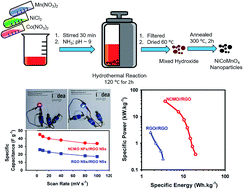Facile synthesis of NiCoMnO4 nanoparticles as novel electrode materials for high-performance asymmetric energy storage devices†
Abstract
In attempt to reduce the amount of toxic Co in cobalt oxides, NiCoMnO4 nanoparticles were synthesized via a facile hydrothermal route and their electrochemical properties have been investigated as a novel electrode material for supercapacitors. Samples have been characterized using X-ray diffraction (XRD), energy dispersive X-ray analysis (EDAX), and X-ray photoelectron spectroscopy (XPS). N2 adsorption/desorption measurements demonstrated a high specific surface area of 175 m2 g−1. The morphology of the samples has been probed with scanning (SEM) and transmission (TEM) electron microscopy. The electrochemical properties of the NiCoMnO4 nanoparticles have been evaluated as electrode materials for energy storage application by means of various electrochemical techniques including cyclic voltammetry, galvanostatic charge–discharge measurements, and electrochemical impedance spectroscopy. According to the obtained results, the NiCoMnO4 electrodes showed significant improved capacitive performance in comparison with pure oxides (e.g. NiO, Co3O4, and Mn3O4). The NiCoMnO4 electrodes with a high mass loading of ∼10 mg cm−2 exhibited a high specific capacitance of 510 F g−1 at 1 A g−1, and a desirable rate capability (retaining 285 F g−1 at 10 A g−1). Finally, asymmetric devices based on NiCoMnO4 nanoparticles as positive electrodes and reduced graphene oxide nanosheets as negative electrodes were assembled, showing a remarkable performance including high energy (20 W h kg−1), and stunning power density (37.5 kW kg−1).


 Please wait while we load your content...
Please wait while we load your content...